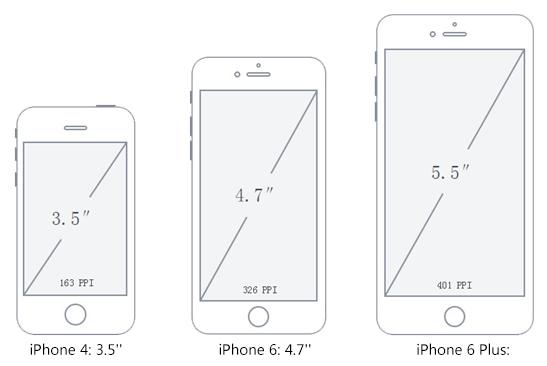移动web开发之屏幕三要素 - 小火柴的蓝色理想
前面的话
实际上,并没有人提过屏幕三要素这个词,仅是我关于移动web开发屏幕相关部分总结归纳的术语。屏幕三要素包括屏幕尺寸、屏幕分辨率和屏幕像素密度。
屏幕尺寸
我们常常听说5.5英寸大屏幕手机,实际上屏幕尺寸是指屏幕的对角线长度。常见的屏幕尺寸有3.5、4、4.3、4.8、5.0、5.2、5.5、6.0等
对于英寸没有什么概念,可以通过转换公式转换成常用的厘米
1英寸 = 2.54厘米
<span style="color: #000000;">3.5in = 3.5*2.54cm = 8.89cm 4.0in = 4.0*2.54cm = 10.16cm 4.3in = 4.3*2.54cm = 10.922cm 4.8in = 4.8*2.54cm = 12.192cm 5.0in = 5.0*2.54cm = 12.7cm 5.2in = 5.2*2.54cm = 13.208cm 5.5in = 5.5*2.54cm = 13.97cm 6.0in = 6.0*2.54cm = 15.24cm</span>

屏幕分辨率
屏幕分辨率是指屏幕的像素点数,一般以纵向像素*横向像素来表示分辨率。显示常用分辨率有如800*600、1024*768、1280*720、1600*900、1920*1080,单位是px
[注意]关于像素的相关知识移步至此
若存在retina视网膜屏幕,要注意的是屏幕分辨率指的是设备像素,而不是理想视口
【HD和4K】
现在移动设备、智能电视宣传最多的两个关键词估计就是HD、4K,这二者都是用来描述显示设备分辨率的标准,到底二者之间有什么区别?
HD:没有固定的标准,基本上只要宽度为720px的都算是HD
full HD(全高清): 1920*1080分辨率
4K: 4k也叫QHD或UHD(超高清),最小分辨率是3840*2160,主要是现在高端电视的分辨率;其还有一个更高的4096x2160的标准,主要用于电影放映机或者专业相机。

【关于相机像素】
我们常常听过相机支持1000万像素。相机所说的像素,其实是最大像素的意思,像素是分辨率的单位,这个像素值仅仅是相机所支持的有效最大分辨率。
<span style="color: #000000;">640*480 = 307200 = 30万像素 1600*1200 = 1920000 = 200万像素 3264*2488 = 8120832 = 800万像素 4536*3024 = 13716864 = 1400万像素</span>
DPI和PPI
DPI(Dots Per Inch)是印刷行业中用来度量空间点密度用的,这个值是打印机每英寸可以喷的墨汁点数。计算机显示设备从打印机中借鉴了DPI的概念,由于计算机显示设备中的原子单位不是墨汁点而是像素,所以就创造了PPI(Pixels Per Inch),这个值是屏幕每英寸的像素数量,即像素密度(Screen density)。由于各种原因,目前PPI(主要是iOS)和DPI(比如在Android中)都会用在计算机显示设备的参数描述中,不过二者的意思是一样的,都是代表屏幕像素密度。
屏幕像素密度(DPI或PPI) = 对角线分辨率 / 屏幕尺寸

勾股定理算出对角线的分辨率:√(1920²+1080²)≈2203
对角线分辨率除以屏幕尺寸:2203/5≈440dpi
DPI = 对角线分辨率 / 屏幕尺寸
以iphone3s和iphone4为例,二者屏幕尺寸一样,屏幕分辨率相差一倍,屏幕像素密度也相差一倍

Google官方指定按照下列标准区分不同设备的dpi

苹果的区分则更为简单:非高清屏、高清屏、超高清屏


//1242*0.87=1080 2208*0.87=1920 3*0.87=2.61
从数值上看,苹果和安卓有这样的对应关系


Hot AI Tools

Undresser.AI Undress
AI-powered app for creating realistic nude photos

AI Clothes Remover
Online AI tool for removing clothes from photos.

Undress AI Tool
Undress images for free

Clothoff.io
AI clothes remover

Video Face Swap
Swap faces in any video effortlessly with our completely free AI face swap tool!

Hot Article

Hot Tools

Notepad++7.3.1
Easy-to-use and free code editor

SublimeText3 Chinese version
Chinese version, very easy to use

Zend Studio 13.0.1
Powerful PHP integrated development environment

Dreamweaver CS6
Visual web development tools

SublimeText3 Mac version
God-level code editing software (SublimeText3)

Hot Topics
 1666
1666
 14
14
 1425
1425
 52
52
 1327
1327
 25
25
 1273
1273
 29
29
 1253
1253
 24
24
 HTML: The Structure, CSS: The Style, JavaScript: The Behavior
Apr 18, 2025 am 12:09 AM
HTML: The Structure, CSS: The Style, JavaScript: The Behavior
Apr 18, 2025 am 12:09 AM
The roles of HTML, CSS and JavaScript in web development are: 1. HTML defines the web page structure, 2. CSS controls the web page style, and 3. JavaScript adds dynamic behavior. Together, they build the framework, aesthetics and interactivity of modern websites.
 The Future of HTML, CSS, and JavaScript: Web Development Trends
Apr 19, 2025 am 12:02 AM
The Future of HTML, CSS, and JavaScript: Web Development Trends
Apr 19, 2025 am 12:02 AM
The future trends of HTML are semantics and web components, the future trends of CSS are CSS-in-JS and CSSHoudini, and the future trends of JavaScript are WebAssembly and Serverless. 1. HTML semantics improve accessibility and SEO effects, and Web components improve development efficiency, but attention should be paid to browser compatibility. 2. CSS-in-JS enhances style management flexibility but may increase file size. CSSHoudini allows direct operation of CSS rendering. 3.WebAssembly optimizes browser application performance but has a steep learning curve, and Serverless simplifies development but requires optimization of cold start problems.
 The Future of HTML: Evolution and Trends in Web Design
Apr 17, 2025 am 12:12 AM
The Future of HTML: Evolution and Trends in Web Design
Apr 17, 2025 am 12:12 AM
The future of HTML is full of infinite possibilities. 1) New features and standards will include more semantic tags and the popularity of WebComponents. 2) The web design trend will continue to develop towards responsive and accessible design. 3) Performance optimization will improve the user experience through responsive image loading and lazy loading technologies.
 HTML vs. CSS vs. JavaScript: A Comparative Overview
Apr 16, 2025 am 12:04 AM
HTML vs. CSS vs. JavaScript: A Comparative Overview
Apr 16, 2025 am 12:04 AM
The roles of HTML, CSS and JavaScript in web development are: HTML is responsible for content structure, CSS is responsible for style, and JavaScript is responsible for dynamic behavior. 1. HTML defines the web page structure and content through tags to ensure semantics. 2. CSS controls the web page style through selectors and attributes to make it beautiful and easy to read. 3. JavaScript controls web page behavior through scripts to achieve dynamic and interactive functions.
 HTML: Building the Structure of Web Pages
Apr 14, 2025 am 12:14 AM
HTML: Building the Structure of Web Pages
Apr 14, 2025 am 12:14 AM
HTML is the cornerstone of building web page structure. 1. HTML defines the content structure and semantics, and uses, etc. tags. 2. Provide semantic markers, such as, etc., to improve SEO effect. 3. To realize user interaction through tags, pay attention to form verification. 4. Use advanced elements such as, combined with JavaScript to achieve dynamic effects. 5. Common errors include unclosed labels and unquoted attribute values, and verification tools are required. 6. Optimization strategies include reducing HTTP requests, compressing HTML, using semantic tags, etc.
 HTML vs. CSS and JavaScript: Comparing Web Technologies
Apr 23, 2025 am 12:05 AM
HTML vs. CSS and JavaScript: Comparing Web Technologies
Apr 23, 2025 am 12:05 AM
HTML, CSS and JavaScript are the core technologies for building modern web pages: 1. HTML defines the web page structure, 2. CSS is responsible for the appearance of the web page, 3. JavaScript provides web page dynamics and interactivity, and they work together to create a website with a good user experience.
 HTML: Is It a Programming Language or Something Else?
Apr 15, 2025 am 12:13 AM
HTML: Is It a Programming Language or Something Else?
Apr 15, 2025 am 12:13 AM
HTMLisnotaprogramminglanguage;itisamarkuplanguage.1)HTMLstructuresandformatswebcontentusingtags.2)ItworkswithCSSforstylingandJavaScriptforinteractivity,enhancingwebdevelopment.
 From Text to Websites: The Power of HTML
Apr 13, 2025 am 12:07 AM
From Text to Websites: The Power of HTML
Apr 13, 2025 am 12:07 AM
HTML is a language used to build web pages, defining web page structure and content through tags and attributes. 1) HTML organizes document structure through tags, such as,. 2) The browser parses HTML to build the DOM and renders the web page. 3) New features of HTML5, such as, enhance multimedia functions. 4) Common errors include unclosed labels and unquoted attribute values. 5) Optimization suggestions include using semantic tags and reducing file size.




